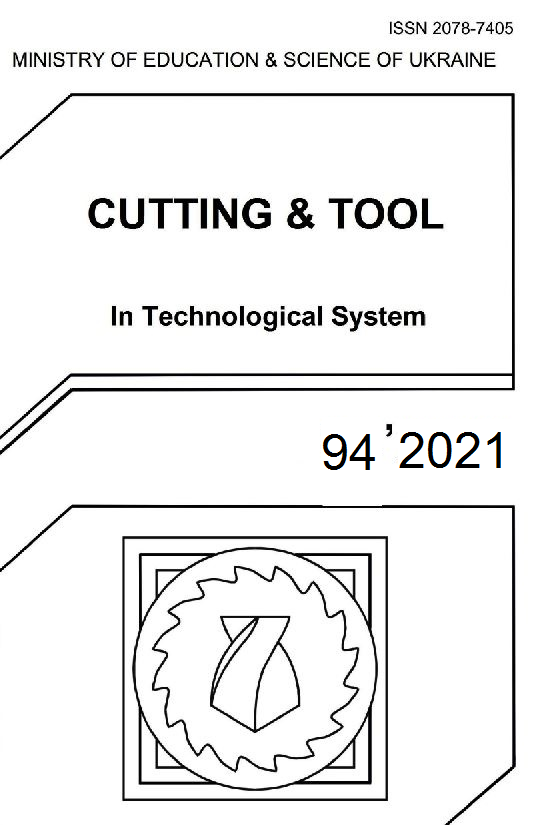EXPERIMENTAL INVESTIGATION OF SURFACE TOPOGRAPHY OF AL7075-T6 ALLOY MACHINED BY EDM
DOI:
https://doi.org/10.20998/2078-7405.2021.94.01Keywords:
Electrical discharge machining, Aluminum alloys, Surface topography, Surface roughness, Peak current, Pulse-on timeAbstract
Electrical discharge machining is one of the most important non-conventional machining processes for removing material from electrically conductive materials by the use of controlled electric discharges. EDM is a non-contact machining process, therefore, is free from mechanical stresses. This paper investigates the machining Al7075-T6 alloy by EDM using a copper electrode. Al7075-T6 alloy was selected, because of its growing use in a lot of engineering applications. The effect of electrical parameters, peak current and pulse-on time, on the surface integrity, was studied. Area surface roughness parameters (arithmetical mean height, Sa, and maximum height, Sz) were measured on all samples and 3D surface characterization has been carried out with confocal laser scanning microscopy. The experimental results showed that the surface roughness is mainly affected by the pulse-on time.
References
Muhammad Pervej Jahan, Ed., Electrical Discharge Machining (EDM): Types, Technologies and Applications. New York: Nova Science Publishers, 2015
M. Niamat, S. Sarfraz, E. Shehab, S. O. Ismail, and Q. S. Khalid, “Experimental Characterization of Electrical Discharge Machining of Aluminum 6061 T6 Alloy using Different Dielectrics,” Arab. J. Sci. Eng., vol. 44, no. 9, pp. 8043–8052, 2019, doi: 10.1007/s13369-019-03987-4
K. H. Ho and S. T. Newman, “State of the art electrical discharge machining (EDM),” Int. J. Mach. Tools Manuf., vol. 43, no. 13, pp. 1287–1300, 2003, doi: 10.1016/S0890-6955(03)00162-7
K. Dehghani, A. Nekahi, and M. A. M. Mirzaie, “Optimizing the bake hardening behavior of Al7075 using response surface methodology,” Mater. Des., vol. 31, no. 4, pp. 1768–1775, 2010, doi: 10.1016/j.matdes.2009.11.014
A. Gatto, E. Bassoli, and L. Iuliano, “Performance Optimization in Machining of Aluminium Alloys for Moulds Production: HSM and EDM,” Alum. Alloy. Theory Appl., 2011, doi: 10.5772/14847
Kasman and N. Tosun, “Investigation of surface roughness in machining of aluminum alloy with EDM,” no. May, pp. 101–104, 2015
B. C. Routara, D. Das, M. P. Satpathy, B. K. Nanda, A. K. Sahoo, and S. S. Singh, “Investigation on machining characteristics of T6-Al7075 during EDM with Cu tool in steady and rotary mode,” Mater. Today Proc., vol. 26, pp. 2143–2150, 2019, doi: 10.1016/j.matpr.2020.02.462
S. Gopalakannan, T. Senthilvelan, and S. Ranganathan, “Modeling and optimization of EDM process parameters on machining of Al7075-B4C MMC using RSM,” Procedia Eng., vol. 38, pp. 685–690, 2012, doi: 10.1016/j.proeng.2012.06.086
P. Malhotra, R. K. Tyagi, N. K. Singh, and B. S. Sikarwar, “Experimental investigation and effects of process parameters on EDM of Al7075/SiC composite reinforced with magnesium particles,” Mater. Today Proc., vol. 21, pp. 1496–1501, 2020, doi: 10.1016/j.matpr.2019.11.069
S. Kar, S. Chakraborty, V. Dey, and S. K. Ghosh, “Optimization of Surface Roughness Parameters of Al-6351 Alloy in EDC Process: A Taguchi Coupled Fuzzy Logic Approach,” J. Inst. Eng. Ser. C, vol. 98, no. 5, pp. 607–618, 2017, doi: 10.1007/s40032-016-0297-y
H. T. Lee and T. Y. Tai, “Relationship between EDM parameters and surface crack formation,” J. Mater. Process. Technol., vol. 142, no. 3, pp. 676–683, 2003, doi: 10.1016/S0924-0136(03)00688-5
Downloads
Published
Issue
Section
License
Copyright Notice
Authors who publish with this Collection agree to the following terms:
1. Authors retain copyright and grant the Collection right of first publication with the work simultaneously licensed under a Creative Commons Attribution License that allows others to share the work with an acknowledgement of the work's authorship and initial publication in this Collection.
2. Authors are able to enter into separate, additional contractual arrangements for the non-exclusive distribution of the Collection's published version of the work (e.g., post it to an institutional repository or publish it in a book), with an acknowledgement of its initial publication in this Collection.
3. Authors are permitted and encouraged to post their work online (e.g., in institutional repositories or on their website) prior to and during the submission process, as it can lead to productive exchanges, as well as earlier and greater citation of published work.

